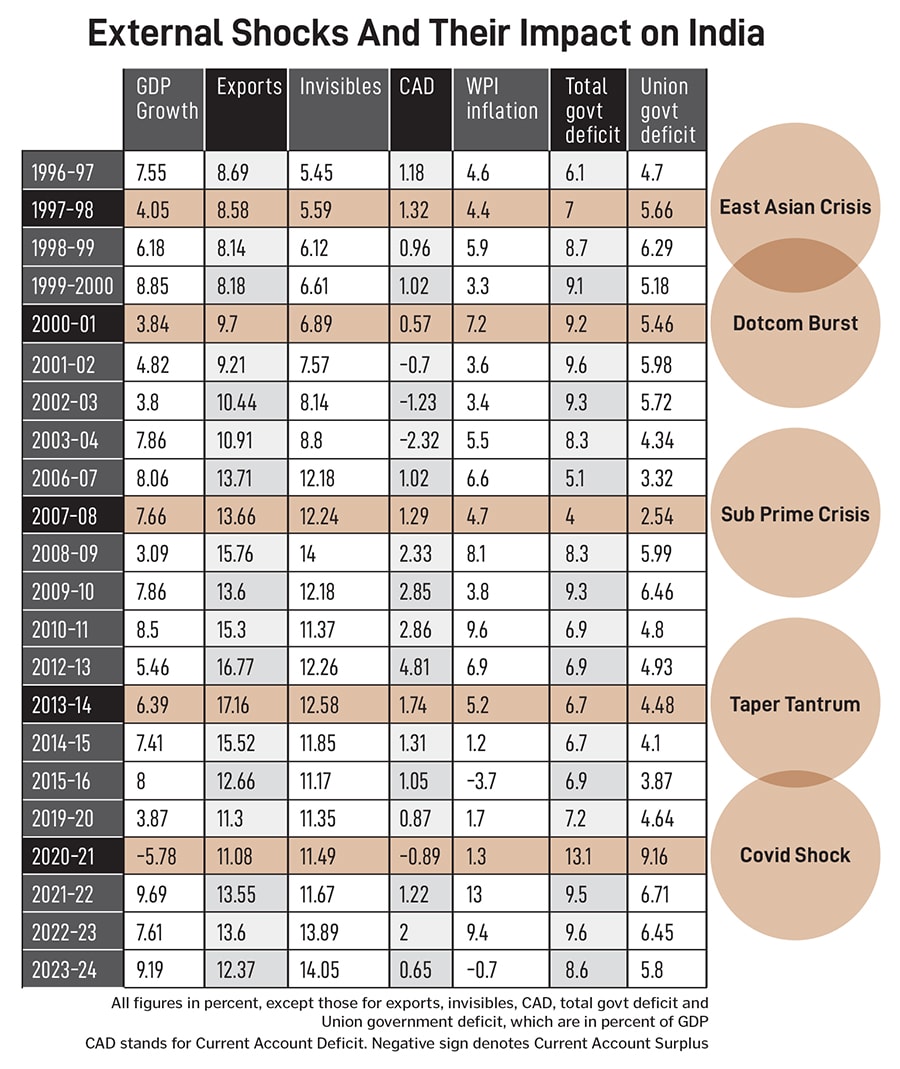How India is reshaping global trade
The country's early engagement with the US on the bilateral deal may place it ahead of the pack in reducing trade tensions. And the FTA with the UK underlines a change in its policy approach—bilateral


Amidst new and uncertain trade tariff policies sparked off by US President Donald Trump, India is gradually stealing the spotlight in the shifting landscape. As the new tariff-driven global trade order compels world economies to renegotiate strategies, those may just turn into opportunities for India. In May, there were two significant changes in this order that could possibly alter the way world economies conduct trade.
The first is the free trade agreement (FTA) between India and the UK after years of negotiations. The second is the temporary reduction of reciprocal tariffs for 90 days between the US and China—the world’s two biggest economies—and India could be its possible beneficiary.
According to Nomura economists Sonal Varma and Aurodeep Nandi, their conversations with policymakers, private sector experts and financial sector participants indicate cautious optimism around the contours of the US-India trade deal, although considerable uncertainty exists around the tariff impact on India. On one hand, there is greater acceptance among most commentators that there will be growth headwinds through the trade, financial and macro uncertainty channels. But there is also optimism that India’s early engagement with the US on the bilateral deal would place it ahead of the pack in reducing trade tensions with the US.
“Along with this, the geo-strategic positioning on China relative to other Asian peers and the likely tariff differential vis-à -vis China for the foreseeable future were cited as key factors behind the optimism," they say.
What works in the Indian economy’s favour are estimates of a normal monsoon, rural recovery, lower inflation and the personal income tax cut announced in the Budget, all of which suggest easing of growth slowdown.
Also, India’s export growth picked up in April despite the initial imposition of Trump’s 10 percent tariffs, while import growth remained strong, driven by both oil and core categories. India’s trade deficit rose to a five-month high of $26.4 billion in April from $21.5 billion in the previous month. This was driven by a sequential increase in imports even as exports moderated after the ramp up seen in March. India’s export growth picked up to 9 percent year-on-year in April from 0.7 percent in March, while import growth also rose sharply to 19.1 percent from 11.4 percent.
“Prima facie, the pickup in export growth to the US in March-April, along with higher import growth from China points to suspected front loading of exports and possible rerouting of exports from China through India, although deeper investigation at the product level is needed to confirm these trends," say the Nomura economists.
However, India’s current trade outlook is murky, given the impact of trade tensions on global growth, the ongoing trade negotiations between India and the US, the recent de-escalation of trade tensions between the US and China and Trump’s disapproval of Apple increasing its manufacturing footprint in India.
Meanwhile, the US and China have agreed to temporarily slash reciprocal tariffs in a deal that surpassed expectations as the world’s two biggest economies seek to end a damaging trade war that has stoked fears of recession and roiled financial markets, according to Reuters.
The US will cut extra tariffs it imposed on Chinese imports in April to 30 percent from 145 percent, and Chinese duties on US imports will fall to 10 percent from 125 percent, the two countries said. The new measures are effective for 90 days.

India and the UK entered into an FTA aimed at fostering bilateral trade and promoting mobility. Tariffs from both sides will be slashed, with a focus on ease of people mobility being pivotal to services exports.
According to Agneshwar Sen, associate partner and leader, trade policy, EY India, the UK-India FTA eliminates tariffs on 99 percent of Indian tariff lines and reduces tariffs on 90 percent of UK lines, potentially boosting the UK economy by £4.8 billion ($6.4 billion) annually by 2040.
Indian sectors such as textiles, leather, agriculture, IT services, engineering goods, auto parts and jewellery are poised to benefit from enhanced market access.
As per CareEdge Ratings estimates, India currently holds a 6 percent market share in the UK’s readymade garment imports, while Bangladesh, Turkey, Cambodia, Vietnam and Italy enjoy duty-free access, giving it a 12 percent tariff advantage over India. India also now has a clear 12 percent duty advantage over China, which holds the largest market share in the UK’s readymade garment imports.
“The India-UK FTA is a game changer for India’s readymade garment imports sector, creating a level-playing field vis-à -vis key competing nations for accessing the nearly $20 billion readymade garment imports market of the UK," says CareEdge Ratings. India is expected to double its market share to 12 percent from 6 percent in 2024 in the UK’s readymade garment imports, translating into an incremental annual export opportunity of around $1.1 to $1.2 billion in the near-to-medium term.
“The FTA is expected to boost Indian participation in IT, finance and digital trade services through commitments on services and professional mobility," Sen says.

In FY24, India’s exports were around $13 billion while imports from the UK were $8.4 billion, thus yielding a surplus of $4.6 billion. In FY25, exports were at $14.5 billion. The chief exports are engineering, readymade garments, chemicals, petro and agro products, among others. In case of imports, besides chemicals and engineering goods, gold was significant.
As the UK is India’s seventh-largest trading partner, accounting for 3.5 percent of India’s total merchandise exports, the FTA is unlikely to alter the current account balance meaningfully, according to economists. The government of India expects the FTA to improve bilateral trade between India and the UK to a total of over $100 billion by 2030.
“India has ensured that non-tariff barriers are suitably addressed to ensure free flow of goods and services and that they do not create unjustified restrictions to India’s exports. The FTA seeks to promote good regulatory practices and enhance transparency that are in sync with India’s own focus on domestic reforms to enhance the ease of doing business," says Madan Sabnavis, chief economist, Bank of Baroda.
The FTA will mean 85 percent tariff lines and 66 percent of existing Indian imports from the UK will be eligible for tariff-free entry into India. This will include UK food and drinks, such as chocolate, gingerbread and sweet biscuits, soft drinks and non-alcoholic beer. It will apply to advanced manufacturing exports such as auto parts, machinery and tools, and medical technology devices, including surgical, dental and veterinary instruments.
India imported whisky worth over £200 million from the UK in 2022 and it currently faces Indian tariffs of 150 percent it will see duties cut to 75 percent on day one and staged to 40 percent from year 10 onwards. Gin will benefit from the same tariff reductions.
UK car manufacturers will benefit from a quota that reduces tariffs from over 100 percent to 10 percent. This starts with internal combustion engine (ICE) cars but transitions to electric vehicles (EVs) and hybrid to reflect how manufacturing in the UK is evolving. Similarly, Indian access to the UK market for EVs and hybrid is also staged and under a quota to support the UK auto industry’s transition to fully EVs.
This deal will cut tariffs for UK cosmetics and toiletries exporters, which have seen a rapid rise in Indian sales recently, despite current tariffs of 10 to 20 percent. Through this deal, tariffs on soaps, shaving cream, face cream and nail polish will either be removed on day one or after staging over 10 years. Perfumes and eau de cologne will see tariffs of 20 percent halved after staging, increasing the opportunity for exporters and reducing costs. However, the deal excludes sectors such as sugar, milled rice, pork, chicken and eggs.
“While the UK per se is not a significant trading partner for India, this paves the way for similar agreements with other countries like the US and EU, and hence augurs well for India. The FTA will also ensure momentum builds up in our bilateral trade with the UK," Sabnavis adds.
“The conclusion of the FTA underlines the change in India’s policy approach to a focus on bilateral trade agreements rather than regional trade agreements," says Aastha Gudwani, India chief economist, Barclays.
With slowing global trade, Gudwani believes having a pipeline of such bilateral trade agreements represents a prudent policy choice. This follows previous agreements signed with Mauritius (2021), Australia (2022), the UAE (2022) and EFTA (2024), and is set to be followed by trade deals with the US (fall 2025) and the EU (end-2025).
Timelines for the FTA between India and UK to come into effect are yet to be finalised.
However, there are concerns about unaddressed issues on UK’s CBAM (Carbon Border Adjustment Mechanism), which seeks to impose duties on carbon-intensive imports. India has proposed a “rebalancing mechanism" which would require the UK to compensate the Indian industry for losses incurred due to the regulation. The UK government plans to introduce the UK CBAM by 2027.
First Published: May 22, 2025, 12:58
Subscribe Now